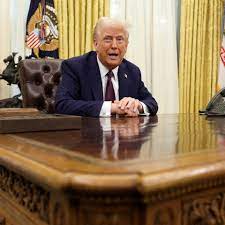EROME – Trade wars have always been a game of give and take. But when former U.S. President Donald Trump introduced his reciprocal tariff strategy, the global trade landscape changed dramatically. Some industries and countries thrived, while others struggled. So, who won and who lost in this economic showdown? Let’s break it down in simple terms.
Table of Contents
| Sr# | Headings |
|---|---|
| 1 | Understanding Trump’s Reciprocal Tariff Strategy |
| 2 | The Logic Behind Reciprocal Tariffs |
| 3 | Winners in Trump’s Tariff Strategy |
| 4 | U.S. Steel and Aluminum Industries |
| 5 | Domestic Manufacturing Boom |
| 6 | Agriculture: A Double-Edged Sword |
| 7 | Losers in Trump’s Tariff Strategy |
| 8 | U.S. Farmers and Export-Dependent Businesses |
| 9 | American Consumers Paying the Price |
| 10 | China and Other Targeted Countries |
| 11 | Impact on Global Trade Relations |
| 12 | Stock Market Fluctuations and Investor Sentiment |
| 13 | The Future of Tariff Policies |
| 14 | Lessons Learned from Trump’s Trade War |
| 15 | Final Thoughts: Who Really Won? |
Understanding Trump’s Reciprocal Tariff Strategy
Trump’s reciprocal tariff strategy was built on a simple premise: If another country imposes high tariffs on U.S. goods, the U.S. will do the same in return. The goal? Level the playing field for American businesses and reduce trade deficits.
The Logic Behind Reciprocal Tariffs
The idea of reciprocal tariffs sounds fair, right? If a country like China charges a 25% tariff on American cars, why shouldn’t the U.S. do the same? But in reality, trade isn’t always that straightforward. Some industries benefit, while others take a hit.
Winners in Trump’s Tariff Strategy
U.S. Steel and Aluminum Industries
One of the biggest winners was the steel and aluminum industry. When Trump slapped tariffs on imported steel, local producers saw a surge in demand. Companies like U.S. Steel and Alcoa reported higher profits.
Domestic Manufacturing Boom
Tariffs on foreign goods made American-made products more competitive. Companies that relied on domestic supply chains thrived, and some manufacturers even brought jobs back to the U.S.
Agriculture: A Double-Edged Sword
While some American farmers suffered from retaliatory tariffs, others benefited from government subsidies meant to offset losses. Soybean farmers were hit hard, but corn and wheat producers saw new opportunities.
Losers in Trump’s Tariff Strategy
U.S. Farmers and Export-Dependent Businesses
Many American farmers lost international buyers due to retaliatory tariffs, especially from China. Exports of soybeans, pork, and dairy plummeted, forcing some farmers out of business.
American Consumers Paying the Price
Tariffs often lead to higher prices for goods. Everything from cars to electronics became more expensive as companies passed the costs onto consumers.
China and Other Targeted Countries
China was a direct target of Trump’s tariffs, facing billions in duties on goods like electronics and textiles. But China fought back, slapping tariffs on American goods, leading to a full-blown trade war.
Impact on Global Trade Relations
Trump’s tariff policies strained relations with traditional allies. Countries like Canada, Mexico, and the European Union imposed their own counter-tariffs, leading to tensions in trade agreements.
Stock Market Fluctuations and Investor Sentiment
The financial markets reacted sharply to Trump’s trade policies. Stocks of companies affected by tariffs saw wild swings, with investors uncertain about the long-term impact.
The Future of Tariff Policies
Biden took a different approach, but the legacy of Trump’s tariffs still lingers. Some tariffs remain, while trade negotiations continue.
Lessons Learned from Trump’s Trade War
If there’s one lesson to take away, it’s that trade wars create both winners and losers. The real challenge is balancing protectionism with economic growth.
Final Thoughts: Who Really Won?
So, who came out on top? Some industries thrived, while others suffered. But in the end, tariffs are a double-edged sword—what helps one sector often hurts another.
FAQs
1. What is Trump’s reciprocal tariff strategy?
Trump’s strategy imposed tariffs on countries that taxed U.S. goods at high rates, aiming to create a level playing field for American businesses.
2. Who benefited the most from Trump’s tariffs?
U.S. steel and aluminum industries saw major benefits, along with some domestic manufacturers who relied less on foreign imports.
3. How did consumers react to the tariff strategy?
Many consumers faced higher prices on everyday goods, from cars to electronics, as businesses passed tariff costs onto buyers.
4. Did Trump’s tariffs hurt U.S. farmers?
Yes, many farmers lost access to key markets like China, leading to lower sales and financial struggles, despite government subsidies.
5. Are Trump’s tariffs still in place today?
Some tariffs remain under Biden’s administration, but trade policies continue to evolve through negotiations and revisions.
